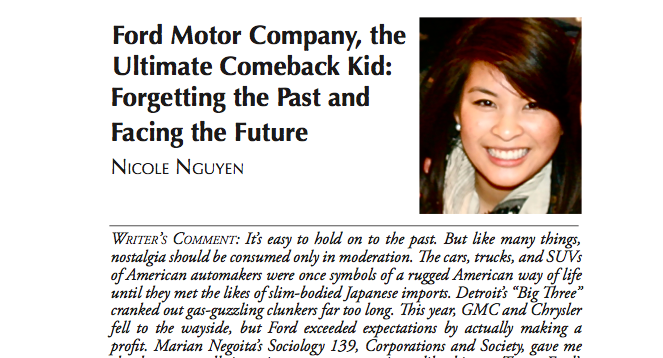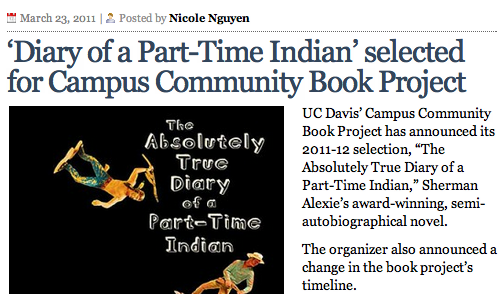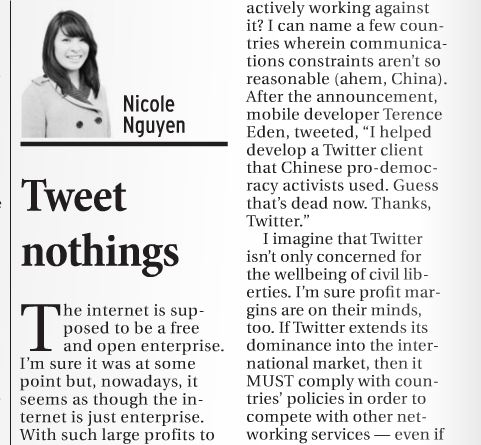Appeared in the 2009-2010 edition of Prized Writing
Instructor’s Comment: Nicole’s paper was developed in response to an assignment for the “Corporations and Society” course that I taught in winter quarter of 2010. This was arguably the most important piece of writing for that course—a ten-page research paper where students had to choose an important research question and really delve into the intricacies of their case study. From the previous class assignments, I already knew that Nicole had stellar writing skills. The additional elements that she brought to this particular assignment were her remarkable ability to see the “big picture,” the considerable amount of time she spent doing research, and the wonderful restraint and focus that she showed in the writing. Indeed, her account of Ford’s “rise, fall, rise again” story reads more like one of the better graduate essays than an undergraduate research paper. And, last but not least, this is a very enjoyable piece of writing to read, with Nicole’s keen sense of irony, tragedy, and redemption on full display.
—Marian Negoita, Sociology Department
Writer’s Comment: It’s easy to hold on to the past. But like many things, nostalgia should be consumed only in moderation. The cars, trucks, and SUVs of American automakers were once symbols of a rugged American way of life until they met the likes of slim-bodied Japanese imports. Detroit’s “Big Three” cranked out gas-guzzling clunkers far too long. This year, GMC and Chrysler fell to the wayside, but Ford exceeded expectations by actually making a profit. Marian Negoita’s Sociology 139, Corporations and Society, gave me the chance to really investigate contemporary issues like this one. To me, Ford’s recent success epitomizes what many corporations face today—a resistance to change, a constantly-evolving market, and politically-induced challenges. It’s impressive what Ford has done to adapt to the modern age of hybrid and electric vehicles. Maybe after reading, you’ll consider buying a Ford. Maybe.
—Nicole Nguyen
I. Introduction
Ford Motor Company is a company of many contradictions. On the one hand, its founder, Henry Ford, fathered the most innova- tive and efficient production method of its time, producing auto- mobiles in quantities the world had not yet seen, and putting Ford at the forefront of the auto industry. The revolutionary assembly line made concrete Ford’s place in American history. The blue-oval brand was syn- onymous with tradition, longevity and, most of all, the rugged American frontier. But on the other hand, it was that very same historic Fordist model and mentality that precipitated the automaker to fall behind newer Japanese innovations that came to dominate the market. When foreign imports from the likes of Toyota, Honda, and Nissan were released in the 1970s, the technology from the early 1900s brought to the world stage by the Detroit, Michigan, automaker seemed clunky and outdated compared to the sleek, small-bodied Japanese cars. Consumers preferred the quiet finesse of Asian automobiles, and Ford Motor Company met hard times because of it.
The economic crisis of 2008 delivered yet another blow to the floundering American auto industry. Ford’s American auto counter- parts, General Motors and Chrysler, found themselves at the mercy of the U.S. government to bail them out. It was widely held that the “Big Three” were essentially cut from the same fabric—all centrally located in Detroit, Michigan, all selling similar vehicles, all supplied by the same manufacturers. Why, then, was Ford not also on its knees, asking for money? Why, then, did it seem as though Ford had managed not to fail, while its fellow Detroiters did? Most did not know that Ford’s departure from the American automaker pack was a long time coming. Its willing- ness to start anew speaks volumes about the legacy of the now fourth gen- eration family company. The corporation abandoned its Fordist roots to ultimately protect the longevity of its iconic brand. This paper considers how Ford’s history paved the way for the company’s most recent success, making it one of the most resilient automakers in America.
II. Road to Greener Pastures
The young Ford Motor Company of 1914 was not at all concerned with competition. That year, Henry Ford’s assembly line dramatically transformed the rate at which cars could be made. In 1914, sales of the Ford Model T hit 250,000 per year and by 1916, sales increased to 472,000. To maximize efficiency, Ford devised the uninterrupted assembly line, a result of his obsession with time-and-motion studies. Frederich W. Taylor’s The Principles of Scientific Management approached the production method as an exact science, extracting the humanity out of the labor force and instead making workers into a small portion of a greater mechanical system that transformed parts into products. The nature of the work may have been dehumanizing, but Ford Motor Company was not ready to renounce a system that brought them great prosperity.
The Fordist way was undoubtedly successful throughout the early 1900s, but Ford’s profitability took a downturn in the latter half of the twentieth century. Gerard Bordenave’s “Crisis and Recovery at the Ford Motor Company” distinguishes three phases during which Ford grappled with various internal and external challenges. From the late 1960s to ‘70s, Bordenave argues that “the traditionalist Fordist model was los- ing its momentum.” He goes on to illustrate Ford’s “experiments” with new organizational techniques in the 1980s and the company’s desper- ate attempt at “strategic consolidation” in the 1990s. Most notable is the period during which the troubled Fordist model began to fail in the 1960s, because it reveals why Ford was not as competitive with Japanese automakers as it could have been. Bordenave points to high turnover rates of laborers, a “hire-and-fire” system, and more generally to the fact that Ford fixated on improvements to auto parts, rather than on human resources. For the next decade, and well into the ‘80s, it became clear to Ford that the existing system was inefficient.
Ford’s neglect of human resources proved particularly damaging because the system was fundamentally flawed. Growing tensions between employer and employee made it difficult for Ford to retain employees. In Trust: The Social Virtues and Creation of Prosperity, Francis Fukuyama discusses how long-term corporate success depends on trust—that is, on a corporation’s faith in an employee’s intellectual capacity to make decisions. According to Fukuyama, the Fordist method was completely at odds with that conviction. The low-trust, rule-based system Ford employed rationalized what Fukuyama describes as a “carrot-and-stick” approach—more pay for more productivity. Henry Ford himself, in his autobiography My Life and Work, explains that his practices are efficient as a result of “the reduction of the necessity for thought on the part of the worker and the reduction of his movements to a minimum. [The worker] does as nearly as possible one thing with only one movement.” Ford Motor Company was built upon an inherent distrust of the worker, inhibiting as much initiative, judgment, and creativity as possible.
Ford’s reluctance to change their management and labor practices may be explained by the company’s tendency to cling onto history as the authority of reason. The idea that individuals are “passive, rational and isolated” and “respond primarily to the stimulus of narrow self-interest” is rooted in the economic history of eighteenth-century thinkers like Adam Smith. Smith’s idea is best defined by this line from his book The Wealth of Nations: “It is not from the benevolence of the butcher, the brewer, or the baker that we expect our dinner, but from their regard to their own interest.” Ford and Taylor integrated Smith’s view of the apathetic economic man into their systems, a view that remained the status quo until a major slump compelled the company to look at newer, more collaborative production processes.
The collapse of the antiquated Fordist system in 1982 followed a second oil crisis, increased government intervention and, above all, competition from Japanese automakers. American and Japanese automakers were competing not only for consumers, but for employees as well. Lean production, the most significant Japanese contribution to the industry, was a turn toward the team-oriented idea, championing company as family, a sentiment that appealed to many Americans and proved to be a revolution in social relations. The Big Three, but especially Ford, did not respond well to the Asian invasion of the car industry, especially when Nissan, Toyota, and Honda moved their production sites to small-town America, with their lean manufacturing productions in tow.
Ford acted swiftly in response, constructing what Bordenave called a “vigorous programme” in the 1980s to jumpstart the company back to its former state of success. Aspiring to match the success of their foreign competitors, Ford Motor Company implemented the Japanese lean production system more comprehensively, according to Fukuyama, in North American plants than did General Motors and Chrysler. Bordenave also supports this claim: “Ford was the most advanced Western producer as far as the adoption of lean production was concerned.” The alacrity with which Ford moved to a new technique entirely, relinquishing years of tradition, is the single, most distinctive indication that the corporation was more fit to survive the economic crisis of 2008 than their American automaking counterparts.
Facilitating that speedy switch to lean production was Ford’s unique corporate culture and social embeddedness in the Detroit community. The company-as-family view that was originally attributed to Japanese lean manufacturing production was an integral part of the Ford system as well. But unlike Japanese lean manufacturing, that close-knit culture existed outside the plant, not on the assembly floor. Employees of Japanese automakers interacted intimately in the plant as a group, a single unit to complete the production of an automobile. Ford employees related to each other as neighbors, as part of a close-knit community that was nearly entirely comprised of Ford employees, and the company made efforts to assume responsibility of the employees. Fukuyama contends that Ford, seeing the “highly stressful and dangerous nature of the work,” “reacted negatively to the conditions he saw in his own plant” and fashioned several labor innovations—doubling the wage to $5 a day in 1914, establishing a sociological department “responsible for worker welfare,” instituting “an extensive program of English-language training schools,” and making “special efforts to recruit the disabled.” These programs, which Fukuyama perceives as being more human versions of Taylor’s inhuman Principles of Scientific Management, underscore the social embeddedness of the Ford Motor Company within the community. Just as company control had passed down the Ford family for four generations, workers prepared their sons and grandsons to do the same. General Motors and Chrysler were not able to achieve the sense of trust between employer and employee that Ford had, and on that account, were not able to implement lean production as comprehensively.
Through the 1980s and 1990s, the prosperous American economy and rock-bottom gas prices gave rise to profitable Ford sport utility vehicles, asserted by the New York Times as the “answer to the Japanese competition.” Unfortunately for Ford, prosperity did not last. Executive Chairman Bill Ford admitted in a 2008 interview with Larry King that, “with the price of gasoline low in this country, we probably stayed too long with the truck and SUV business model.” Although Bill Ford is a self-proclaimed devoted environmentalist, the complex corporate bureaucracy, comprised of profit-seeking middle managers and senior executives, obstructed his goal to turn product lines into an environmentally-friendly, fuel-efficient endeavor. Turning the company away from family hands and towards controlling administrators turned out to be a bad move. When Toyota beat out Ford in 2006, it became clear that the gas-guzzling vehicles could not contend with the new fuel-efficient Priuses.
Ford nearly hit rock-bottom—depleting sales and profits called for a major overhaul of corporation reorganization and vehicle redesign. In 2006, Ford America’s Division President Mark Fields announced a restructuring plan dubbed The Way Forward, a program to downsize plants and drop unprofitable product lines. Nine plants have already been shut down, with plans for five more closings by 2012. Streamlining the corporation to focus solely on its core products was one of the smartest things Bill Ford did for the Ford Motor Company. In a move to show his commitment to the restructuring plan, Ford acquired $23.6 billion in loans. At the time, the move seemed “an act of desperation, but [it] was actually an act of salvation.” Ford borrowed when there was plenty of credit to be had, and by the time the economic crisis of 2008 hit the world stage, Ford had enough cash on hand to avoid a bailout.
The bottom line here is that Ford did what had to be done—focus. The corporation had a keen awareness of the gravity of its situation and regressing market conditions. The corporation had a sense of reality. Automakers cannot dictate the circumstances under which the auto industry will grow—they are forced to listen to the consumer, and if they fail to do so, they face bankruptcy. The market for cars is extremely sensitive to the shape of the economy and consumer income. Because of this, automakers must apply consumers’ evolving needs and wants to the product, not the other way around.
Currently, Ford is performing its best in a decade, surpassing all investor expectation and breaking profit for its fourth consecutive quarter. The corporation is involved in a series of collaborations and partnerships to make good on its promise for a truly environmentally-conscious Ford future. In January 2009, Ford announced plans to help the country of South Africa enact more sustainable practices in time for the 2010 World Cup. The effort is in association with SMART, a University of Michigan mobility research project to render the transition between shuttle, taxi, and bicycle completely seamless. In June 2009, the Obama Administration granted a $5.9 billion loan to Ford Motor Company to finance numerous engineering advances to “traditional internal combustion engines and electric vehicles, to convert two truck plants to the production of cars, and raise fuel efficiency of more than a dozen popular models.” In February 2010, Ford launched an initiative to improve the energy efficiency of its dealerships. The voluntary program seeks to improve efficiency in the long term to ultimately cut operating expenses. First, dealerships in Florida, New York, and Nevada will undergo pilot tests to assess how sustainable practices can be implemented in three vastly different climates. The energy assessment will lead to necessary energy-efficient changes suited for that particular facility. Most recently, in early April 2010, Ford unveiled a project in partnership with Microsoft to create technology for Ford’s new electric vehicle line. The ambitiously aggressive plan to include five new electric vehicles by 2010 begins by integrating the Microsoft “Hohm” software into the new lines. “Hohm” is a management system that allows users to recharge their vehicles at the most economic times and helps power companies manage electricity demands as more electric vehicles come on to the market. If there is any doubt that the renewed Ford vision has implications for the future, Ford raked in $2.1 billion in earnings in the first quarter of this year, compared to $1.4 billion in losses at this time last year.
Ford’s history indicates how the corporation is uniquely fitted to overcome adversity. This has a lot to do with the fact that the Ford family has such a huge stake in its success. In a 2007 New York Times article titled “Ford, Lift Up Your Weary Head,” Micheline Maynard wrote,
General Motors and Chrysler have their own problems that are weighing on this city [Detroit]. Their headquarters are here, too, as are some of their car plants, and thousands of their employees have their own worries as each company struggles financially.
But Ford is woven more into the fabric of Detroit, with the Ford name on office buildings, museums, high schools and highways, as well as the football stadium, Ford Field, which opened downtown in 2002. The social embeddedness of Ford Motor Company is what sets it apart, locally and globally. Executive Chairman Bill Ford reinforced this notion on Larry King Live in 2009:
We did give home computers a few years ago to all our employees around the world. But I think what underlies all this is the fact that Ford Motor Company, to me, is very much of a family company. Not just my family, but all the employees. And what is really different about us is we have third, fourth and even fifth-generation employees at Ford. The nouveau modernization of Ford’s future is as important as Ford’s legendary past. Its roots, its deep social embededdness allows the corpo- ration to grow up and out. Somehow, in General Motors and German- owned Chrysler, this element is missing.
III. Connections to Polanyi
Ford Motor Company’s staying power can also be assessed in terms of economic theory. Government intervention played an important role in shaping Ford’s fate. Economist and intellectual Karl Polanyi challenged the ideas of the aforementioned Adam Smith by supporting the idea of government regulation. Polanyi’s inherent distrust of the self- regulating market was not unlike Taylor’s inherent distrust of employees. In his The Great Transformation, Polanyi quoted Robert Owens: “Market economy, if left to evolve according to its own laws, would create great and permanent evils.”
If Detroit’s Big Three had been left to act on their own accord, the American economy would either have been devastated from the col- lapse or inflated with gas-guzzling SUVs. The Ford Motor Company was able to succeed only because of the conditions set by a regulated market. Though it first saved itself in 2006 from financial ruin thanks to economic liberalism that made credit widely available, Ford was only able to survive in its later life because of governmental programs like handing out subsidies to consumers who traded in their older models for fuel-efficient American vehicles. Economic liberalism and social protection are two of the push-pull principles of the modern capitalist economy described by Polanyi. Ford used both of these principles to their advantage—a hallmark of a company suited for long-term success.
The rough patches Ford encountered in its history are a testament to the company’s endurance within an unpredictable auto industry. In the continuously changing market for automobiles, consumers behaved not under the classic economic conditions of isolation and passivity but by more substantive means, an economic theory Karl Polanyi developed in The Great Transformation. Consumers desired less car, more efficiency, favoring automakers that helped the environment, not hurt it. Best value, more power no longer represented American interest, and Ford quickly changed its goals to accommodate the rising tide of environmentally conscious cars. Perhaps Ford survived because of its acute sense of what the consumers are responding to—in its early beginnings, lots of transportation, and in its most recent history, lots of innovation.



